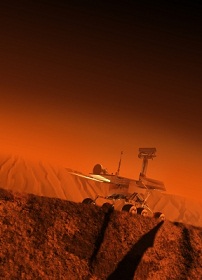NASA Mars probe, Curiosity makes history
In a nail biting adventure, NASA and the Jet Propulsion Laboratory were cheering and crying with glee as their latest Mars probe, Curiosity landed safely on the red planet.
This mission was risky. The probe is large. It’s the size of a SUV and weighs 2,000 pounds on Earth. On Mars it weighs ¼ of that but it was still a major endeavor to get the spacecraft and probe the 150 plus million miles and land it safely on the surface.
There is a 14 minute gap between the time it takes to send a signal from Mars to Earth. It’s because at the speed of light which is roughly 180,000 miles per second, at 150 million miles it takes approximately that long for a signal to travel. That means if the NASA and JPL folks want to turn the rover in a direction or issue a command they’ll have to wait that long to make the rover do that.
The rover is loaded with scientific equipment and sports a nuclear powered system to keep the device and it’s apparati working. It has six wheels and lots of sensors. It’s mission is to look for present and past life on Mars by looking for the building blocks of life such as carbon, amino acids and more.
Scientists know that there is frozen water on Mars. Previous probes and rovers have discovered it. Scientists also know that Mars was once covered in a sea of water and was much warmer. This they feel may have contributed to a number of factors that we know could support life.
This is mankind’s biggest and most expensive hunting and archaeological mission ever. Should there be signs of life or past life it will change the face of science and our history books forever. Not only that it will invite more opportunities to engage in space exploration which will generate more jobs and boos our economies.
There’s a lot riding on this mission and when the probe successfully landed it was quite an achievement. It took levels of mathematics and computing that never before existed. The scientists took almost ten years to bring this mission to fruition and it’s success so far has saved NASA and JPL’s future. The mission is to last 2 years but previous rovers have lasted years. Every aspect of this mission is going to be scrutinized for quite some time because of the continuing stream of data. Exobiologists, botanists, biologists, mineralogists and more will get their mouthfuls of scientific information that will keep them busy for a while.
No one knows at present when the announcement will be made that there was life or that there is life. It is expected that it won’t be immediately as the rover has to cover a lot of ground and perform several experiments. Some speculate that any surviving life would be subsurface thus generating the continual volumes of methane gas that no one knows the origin of.
So the world will have to sit on the edge of their seats until further news comes forth.
Online News Heard Now
Image: FreeDigitalPhotos.net
Short URL: http://www.onlinenewsheardnow.com/?p=1215
